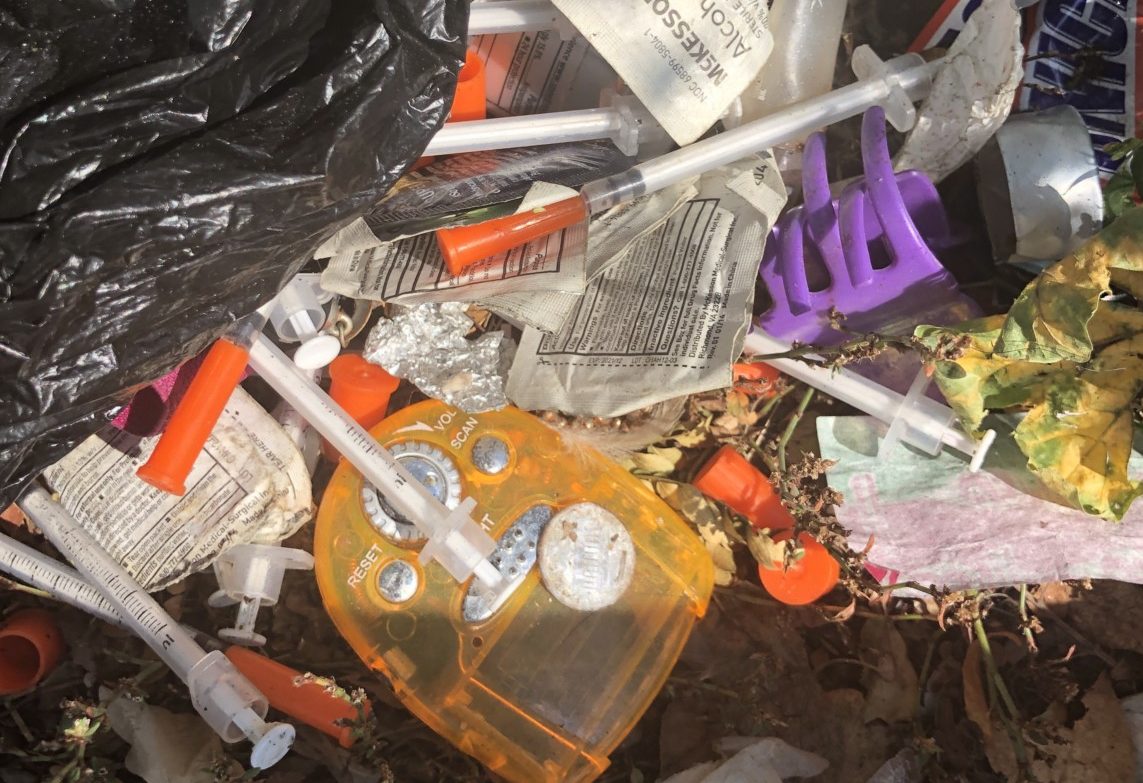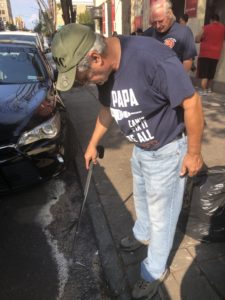
A lifelong resident of the Bronx Marty Rogers walked his familiar route on September 10 down Third Avenue to the Hub at 149th Street, the unofficial shopping and transit heart of the South Bronx. Rogers regularly visits this area dotted with orange plastic pieces of discarded syringes, neon lights alerting to all too familiar problem for the community.
Knowing that students from 10 surrounding schools pass by all this danger and debris every day broke his heart.

“The subliminal message is just killing our kids,” said Rogers, 64, leader of a local grassroots movement called Take Back the Hub focused on bringing attention to this issue. “It wires our kids to become an addict of some kind.”
The message, he said, is that drug use like this is a big part of what’s inevitable for these children.
On two separate days the week of September 10, a walk through the five block area fanning out from 149th Street and Third Avenue found nearly 1,000 pieces of needles and 200 intact syringes. The area observed by The Bronx Ink, included Patterson Playground and Lincoln Medical Center.
In this same area are a total of 10 schools, spanning elementary to high school, both public and charter schools.
The scope of the drug crisis is nothing new to residents of Mott Haven. The neighborhood has the third highest rate of overdose deaths in the city at a rate of 49.2 deaths per 100,000 citizens, according to Epi Data Brief by New York City Health.
“The rates of overdoses in the South Bronx are exceptionally high and if the the South Bronx was its own state it would have one of the highest rates in the country,” said Michelle Nolan, senior epidemiologist for the New York City Department of Health.
This data was gathered using death certificates and information from the medical examiner’s office, which is consistent with the Centers for Disease Control standards, according to Nolan.
What is no longer tenable to the local grassroots activists is how the city’s repeated neglect. The members believe that a lack of quality services, such as police, sanitation and healthcare, is to blame for the opioid problem and the number of discarded syringes.
Rogers calls the area a “zone of neglect.”
Residents can report discarded syringes to 311, according to Dina Montes, Press Secretary of the New York City Department of Sanitation.
“The Department of Sanitation of New York investigates reports of syringes on a City public street or public sidewalk. If any are found, our Environmental Police Unit will collect them and ensure their proper, safe disposal,” said Montes in an email. “Our Environmental Police Unit found and removed 16 syringes with sharps attached in that area of East 149th Street on Tuesday, September 10.”
The committee is not interested in “demonizing” those suffering from addiction, according to Rogers.
“They are our brothers and sisters,” he said. “They had a very sad situation because they’re addicted, but the real victim is the child that has to walk past the needles and the defecation. That is the victim.”
Roger’s collection of neighbors aren’t the only ones concerned. Antonio Merced, a volunteer at Brilla Middle School at Courtlandt Avenue and 148th Street, regularly uses his cane to bend syringe needles and gather them in a pile on the block before the students enter and leave the school.
“This is what it comes down to: parents, volunteers and guys getting paid who swept the needles up,” Rogers said. “I would challenge anyone to walk three blocks around this area and not find a cap or evidence of drug use.”
The movement plans to hold a vigil every Tuesday in The Hub, at 149th Street and Third Avenue to bring attention to the number of improperly disposed syringes.
“The people who join in, we have to keep reminding them, this isn’t one time,” said Francine Rogers, Marty’s wife. “We have to keep going.”
The office of Bronx Borough President Ruben Diaz Jr. is aware of the situation, according to John DeSio, director of communications.
“Our office is aware of the situation, and have been in regular contact with agencies, the police department, local businesses, non-profits and other stakeholders in the area to develop solutions moving forward,” DeSio said in an email.
Meanwhile, the members of the committee are waiting for the political officials to call a rally and organize to end this problem.
“I think it’s fair to say that the community is more on top of this issue than the political officials,” said Rogers. “I’m not saying they’re not trying but they’re failing.”

